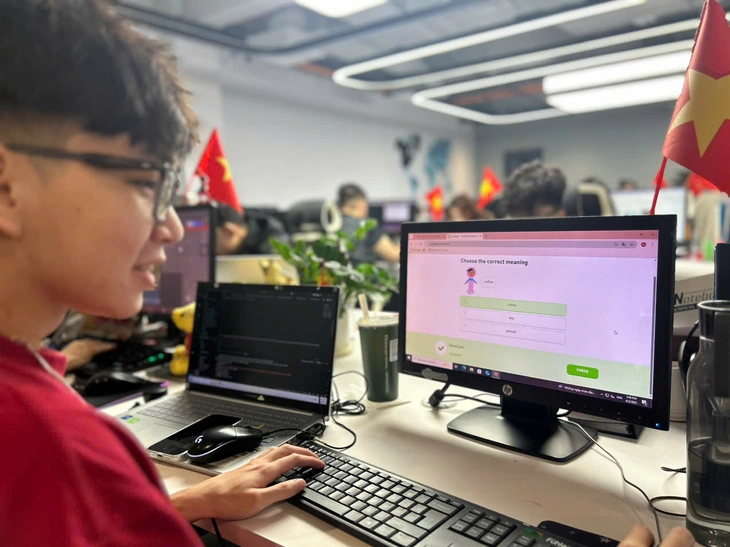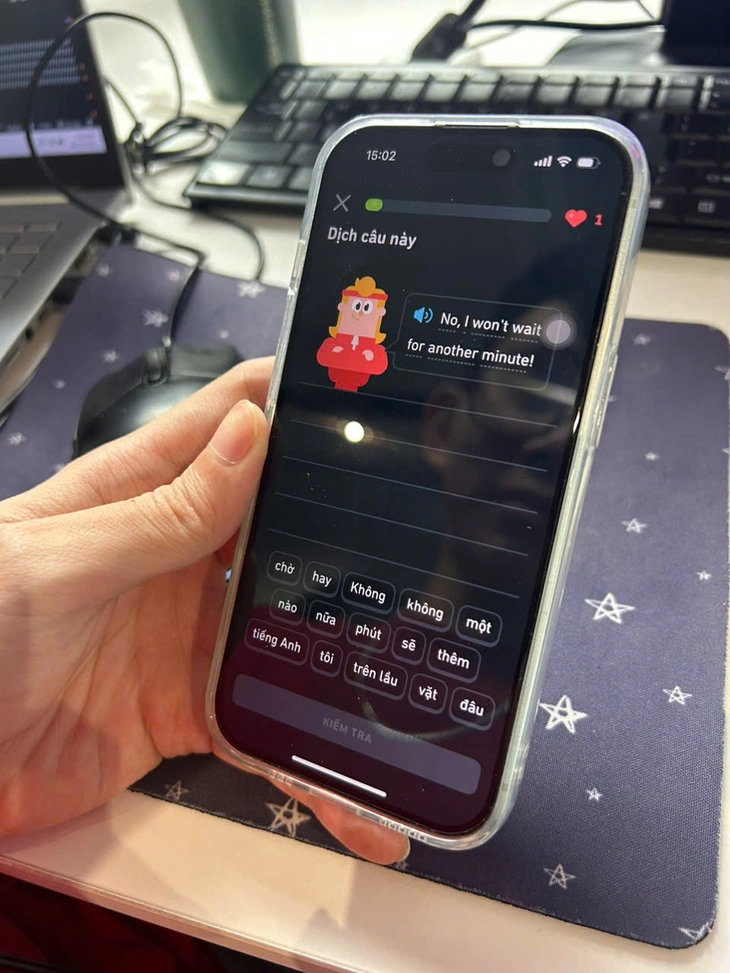
Young people are learning English on the Duolingo platform - Photo: DONG HAI
In the digital age, English is not only a subject but has become an essential tool for students to access global knowledge and expand career opportunities. However, the journey to conquer English, especially speaking skills, often faces three major barriers: low efficiency, high cost and lack of appeal.
Fortunately, the explosion of artificial intelligence (AI) is revolutionizing education , especially in the field of language learning, promising a comprehensive and optimal solution for students.
How is learning English with AI better than the old way?
The challenge of learning "old-style" English
Before we dive into the role of AI, let’s take a look at the challenges students often face when learning English.
Traditional methods lack personalization : Large classes and general curriculum cannot meet the different learning speeds and styles of each student. Speaking practice is limited and feedback is not thorough.
Difficulty in error correction : It is difficult for teachers to monitor and correct pronunciation and grammar errors in detail for each individual in real time, especially in large classes.
Sky-high tuition fees : Courses with native teachers at large centers often require very high fees, causing great financial pressure on students.
Cost of materials and transportation : In addition to tuition, students must also pay for books, materials, and transportation expenses.
Dry content, little interaction : Traditional textbooks are often heavy on theory, not very interesting, easily making students bored and giving up.
Lack of practice environment: Students have few opportunities to practice communication regularly in real or simulated environments, leading to a lack of confidence in speaking.
Learn English with AI

Users say the interface of English learning apps is very easy to use - Photo: DONG HAI
Learning English with AI is highly effective thanks to its personalization and smart interaction.
Personalized learning path : In an interview with Tuoi Tre Online, Mr. Tuan Vi, who is learning English on the Duolingo platform, said: "AI can analyze students' level, strengths, and weaknesses to design appropriate lessons. For example, if a student is weak in grammar, AI will automatically enhance related exercises, instead of applying a common path for all."
Instant Feedback : Unlike traditional teachers, AI provides instant feedback. This helps students correct mistakes in time, such as mispronunciation or using words in the wrong context, thereby improving quickly.
Increased self-learning ability : AI helps students learn anytime, anywhere without depending on a fixed schedule. This is especially suitable for busy students, as they can take advantage of studying on their phones during their free time.
Motivating learning: AI applications often incorporate gamification elements, such as scoring systems, badges, or challenges. This makes learning more fun, encouraging students to maintain their study habits.
Affordable Cost: One of the biggest advantages of learning English with AI is its low cost, which is suitable for students' budget.
Many AI-based English learning apps have free versions with basic features, such as Duolingo or Google Translate. Even the paid versions are very reasonable, often starting at just a few tens of thousands of VND per month, much cheaper than taking traditional courses.
In addition, students can access thousands of free AI-suggested materials, from grammar exercises to video tutorials, without having to buy textbooks or study materials at "painful" fees.
Studying with AI, students also do not need to go to a language center, helping to save travel costs and time, especially for those who live far away or have a busy schedule.
Some ways to learn English with AI
AI has been incorporated into many English learning apps and platforms, helping students approach the language in a flexible and personalized way. Here are some common ways students can apply it:
Use AI-powered language learning apps: Apps like Duolingo, Elsa Speak, and Grammarly use AI to analyze learners’ pronunciation, grammar, and vocabulary. For example, Elsa Speak helps students improve their pronunciation by comparing their voices to native speakers, giving them detailed feedback on how to improve.
Learning through AI chatbots: Chatbots like Replika or Mondly are capable of communicating in English, helping students practice everyday conversations. These tools often simulate real-life situations, from basic communication to job negotiations, helping learners gain confidence.
Leveraging AI for translation and interpretation: Tools like Google Translate or DeepL not only translate but also explain context and word usage, helping students gain a deeper understanding of how to use English in different situations.
AI-powered video and podcast learning: Platforms like YouTube and Spotify use AI to suggest English learning content that matches students’ level and interests. Some tools also automatically generate subtitles, explain new words, or analyze pronunciation in videos.
Learning goes hand in hand with practice
Despite its many advantages, learning English with AI also has some limitations. First, AI cannot completely replace human interaction, especially in understanding intonation, emotions or communication culture.
Second, learning through applications requires students to be highly disciplined, otherwise they are easily distracted.
To overcome this, students should combine AI learning with real-life practice, such as joining an English club or communicating with international friends.
Source: https://tuoitre.vn/cach-hoc-tieng-anh-bang-ai-bo-re-cho-sinh-vien-20250603154608006.htm



![[Photo] National Assembly Chairman Tran Thanh Man attends the VinFuture 2025 Award Ceremony](/_next/image?url=https%3A%2F%2Fvphoto.vietnam.vn%2Fthumb%2F1200x675%2Fvietnam%2Fresource%2FIMAGE%2F2025%2F12%2F05%2F1764951162416_2628509768338816493-6995-jpg.webp&w=3840&q=75)
![[Photo] 60th Anniversary of the Founding of the Vietnam Association of Photographic Artists](/_next/image?url=https%3A%2F%2Fvphoto.vietnam.vn%2Fthumb%2F1200x675%2Fvietnam%2Fresource%2FIMAGE%2F2025%2F12%2F05%2F1764935864512_a1-bnd-0841-9740-jpg.webp&w=3840&q=75)































































































Comment (0)